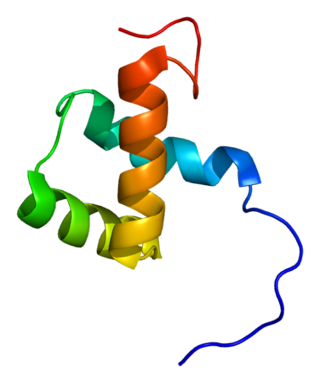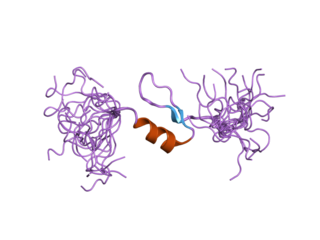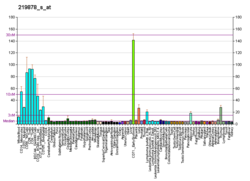
Transcription factor Sp1, also known as specificity protein 1* is a protein that in humans is encoded by the SP1 gene.

Chemokine ligand 5 is a protein which in humans is encoded by the CCL5 gene. The gene has been discovered in 1990 by in situ hybridisation and it is localised on 17q11.2-q12 chromosome.
In molecular genetics, the Krüppel-like family of transcription factors (KLFs) are a set of eukaryotic C2H2 zinc finger DNA-binding proteins that regulate gene expression. This family has been expanded to also include the Sp transcription factor and related proteins, forming the Sp/KLF family.

The vitamin D receptor (VDR also known as the calcitriol receptor) is a member of the nuclear receptor family of transcription factors. Calcitriol (the active form of vitamin D, 1,25-(OH)2vitamin D3) binds to VDR, which then forms a heterodimer with the retinoid-X receptor. The VDR heterodimer then enters the nucleus and binds to Vitamin D responsive elements (VDRE) in genomic DNA. VDR binding results in expression or transrepression of many specific gene products. VDR is also involved in microRNA-directed post transcriptional mechanisms. In humans, the vitamin D receptor is encoded by the VDR gene located on chromosome 12q13.11.

Krueppel-like factor 6 is a protein that in humans is encoded by the KLF6 gene.

Krüppel-like factor 4 is a member of the KLF family of zinc finger transcription factors, which belongs to the relatively large family of SP1-like transcription factors. KLF4 is involved in the regulation of proliferation, differentiation, apoptosis and somatic cell reprogramming. Evidence also suggests that KLF4 is a tumor suppressor in certain cancers, including colorectal cancer. It has three C2H2-zinc fingers at its carboxyl terminus that are closely related to another KLF, KLF2. It has two nuclear localization sequences that signals it to localize to the nucleus. In embryonic stem cells (ESCs), KLF4 has been demonstrated to be a good indicator of stem-like capacity. It is suggested that the same is true in mesenchymal stem cells (MSCs).

Krueppel-like factor 5 is a protein that in humans is encoded by the KLF5 gene.

Zinc finger E-box-binding homeobox 1 is a protein that in humans is encoded by the ZEB1 gene.

Krüppel-like Factor 2 (KLF2), also known as lung Krüppel-like Factor (LKLF), is a protein that in humans is encoded by the KLF2 gene on chromosome 19. It is in the Krüppel-like factor family of zinc finger transcription factors, and it has been implicated in a variety of biochemical processes in the human body, including lung development, embryonic erythropoiesis, epithelial integrity, T-cell viability, and adipogenesis.

Transcription factor COE1 is a protein that in humans is encoded by the EBF1 gene. EBF1 stands for Early B-Cell Factor 1.

Krueppel-like factor 10 is a protein that in humans is encoded by the KLF10 gene.

Krueppel-like factor 11 is a protein that in humans is encoded by the KLF11 gene.

Transcription factor Sp2 is a protein that in humans is encoded by the SP2 gene.

Krueppel-like factor 12 is a protein that in humans is encoded by the KLF12 gene.

Krueppel-like factor 8 is a protein that in humans is encoded by the KLF8 gene. KLF8 belongs to the family of KLF protein. KLF8 is activated by KLF1 along with KLF3 while KLF3 represses KLF8.

Zinc finger and BTB domain-containing protein 7B is a protein that in humans is encoded by the ZBTB7B gene. ZFP67 is an early growth response gene that encodes a zinc finger-containing transcription factor that binds to the promoter regions of type I collagen genes and has a role in development.[supplied by OMIM]

Krüppel-like factor 3 is a protein that in humans is encoded by the KLF3 gene.

Krüppel-like factor 15 is a protein that in humans is encoded by the KLF15 gene in the Krüppel-like factor family. Its former designation KKLF stands for kidney-enriched Krüppel-like factor.

Glis1 is gene encoding a Krüppel-like protein of the same name whose locus is found on Chromosome 1p32.3. The gene is enriched in unfertilised eggs and embryos at the one cell stage and it can be used to promote direct reprogramming of somatic cells to induced pluripotent stem cells, also known as iPS cells. Glis1 is a highly promiscuous transcription factor, regulating the expression of numerous genes, either positively or negatively. In organisms, Glis1 does not appear to have any directly important functions. Mice whose Glis1 gene has been removed have no noticeable change to their phenotype.
Glutamate-rich protein 4 is encoded by the gene ERICH4 and can be otherwise known as chromosome 19 open reading frame 69 (C19orf69). ERICH4 is highly conserved in mammals and exhibits overexpression in tissues of the kidneys, terminal ileum, and duodenum. The function of ERICH4 has yet to be well understood by the scientific community but is suggested to contribute to immune inflammatory responses.




















